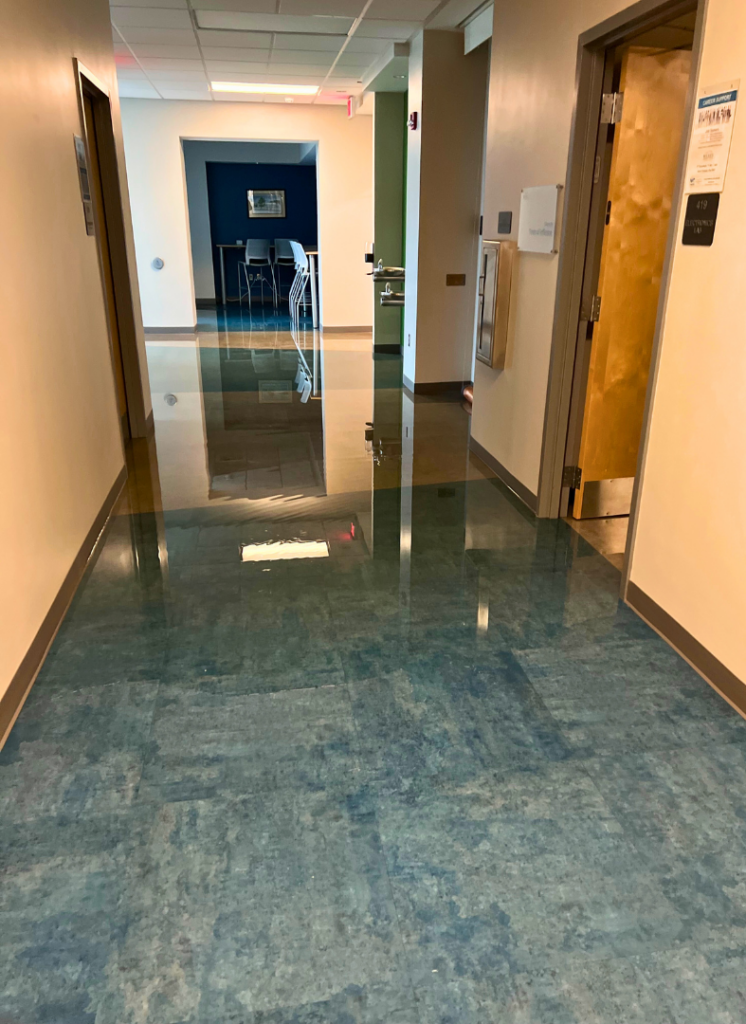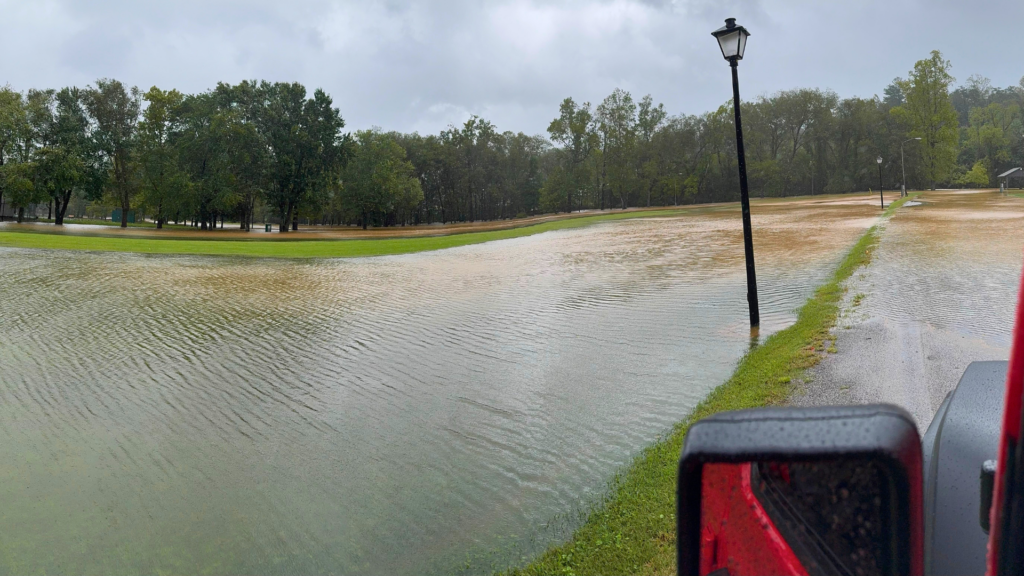Community Colleges Play Vital Role in Disaster Response After Hurricane Helene

Published: October 11, 2024
In the aftermath of Hurricane Helene’s devastation across Western North Carolina, community colleges stepped up as crucial emergency response hubs, supporting relief efforts by federal, state, and nonprofit organizations. With 14 colleges affected by the storm, these community colleges quickly transformed into staging grounds and operational bases for disaster teams, emergency responders, power companies, and displaced residents.
A statewide Helene Relief Fund was created by the North Carolina Community College System and colleges raced to find generators and emergency internet in the days after Helene. The System Office worked with agency partners to drive and helicopter Starlink systems and generators to western colleges.
“Our colleges have always been pillars of support for North Carolina,” said System President Dr. Jeff Cox. “This response to Hurricane Helene showcases their ability to go above and beyond. These campuses are more than educational institutions — they are critical community centers for the communities they serve.”

Colleges Respond to Community Needs
- Asheville-Buncombe Technical Community College (A-B Tech), which has garnered national attention given Asheville’s devastating destruction, became a regional emergency hub, sheltering 179 displaced individuals and providing medical assistance to an additional 60 people. The college also staged 300 ambulances to assist with potential evacuations and housed shelter workers across multiple campuses. “The devastation is unimaginable and has affected every student, employee, and community in our service area,” said President John Gossett. Although the college’s facilities were relatively undamaged, extensive power and water outages across the region led to the postponement of its reopening. “It has become clear that we won’t have water and that our employees and students are heavily impacted and focused on navigating the challenges Helene has caused in their personal lives,” Gossett added.
- Blue Ridge Community College in Hendersonville has been transformed into a multi-functional recovery base, supporting local emergency services, and search and rescue teams. The Health Sciences Campus was designated for triage services to assist the nearby hospital, while other parts of the college served as shelters and staging areas for relief workers. Despite the campus itself facing significant damage, including power, water, and cell service outages, the college quickly adapted. “It is times like these that underscore why the word ‘community’ is in our college’s name,” said President Dr. Laura Leatherwood. “We’re here to serve our neighbors through thick and thin. We’re doing this now, and we’ll be doing it tomorrow.”
- Caldwell Community College & Technical Institute, which is home to hard-hit Boone and Watauga County, opened its doors to Samaritan’s Purse and Duke Energy, providing a critical space for coordinating recovery logistics and staging response operations. The campus became a base for rapid mobilization, ensuring that resources reached impacted areas quickly and efficiently. “The outpouring of kindness and support we have received from across the state since Hurricane Helene has been overwhelming,” said President Dr. Mark Poarch. “Our area will be recovering and rebuilding from the impact of this storm for years to come, but with sufficient support and resources—and a fair amount of mountain grit—we will emerge stronger than ever.”
- Western Piedmont Community College in Morganton became a key player in the region’s recovery efforts, staging 450 trucks and 750 personnel from Duke Energy to support extensive power restoration across the area. “It took us six days just to confirm that all our faculty and staff were safe,” said President Joel Welch. The college is also addressing ongoing challenges for students, as a survey revealed that 20% lack stable internet access, 5% are still without power, and many are struggling with home damage and financial difficulties. “Even now, many students are struggling,” Welch added, emphasizing the long-term impact on the community.
- Wilkes Community College experienced significant damage and was closed for 12 days before opening as a resource center on October 7. Their Ashe Campus provided access to power and internet connectivity for students, employees, and the local community.
- Spruce Pines, home to Mayland Community College, was one of the most devastated areas in Western North Carolina. While they have opened their doors to faculty and staff, there is no timetable yet to resume instruction.
Support for Recovery Efforts
- Haywood Community College provided access to showers and laundry for employees and students, while also housing 40 to 50 displaced individuals each day. The college’s facilities are being used by the local Chamber of Commerce and an engineering firm to continue operations amid the disruption. Emergency responders are expected to establish a base on campus shortly, further bolstering recovery efforts. Additionally, the campus serves as a landing zone for search and rescue helicopters, facilitating rapid deployment in critical situations.
- Isothermal Community College became a crucial staging ground for more than 600 Duke Energy trucks and up to 1,500 personnel, as well as National Guard equipment. In response to the significant communication challenges caused by the loss of cell towers, the college opened its doors to employees and their families, offering essential services such as power, water, WiFi, and meals. President Dr. Margaret Annunziata said, “We recognized that thousands of our students and employees were struggling with outages, unbelievable damage to their homes and properties, and just processing the devastation of the storm.”
- Cleveland Community College not only provided space for community dinners but also accommodated the local Health Department to deliver essential services to residents. As the community continues to navigate recovery, the college remains a vital resource for those in need.
- McDowell Technical Community College provided space as an Emergency Operations Center and helped facilitate a warehouse for donations of basic needs. Their Universal Building supported the shipping and receiving of donations. The campus also housed the Greenville Swift Water Rescue Team and campsite evacuees. “Gratefully, our facilities and infrastructure remained mostly intact. Strong relationships with community agencies positioned us to react quickly to problem solving and serving people,” said McDowell Tech President J.W. Kelley.
- Southwestern Community College’s Jackson Campus served as a staging area for tanker trucks to refuel first responders and stands ready to serve as an overflow shelter when needed.
Many other counties saw significant damage to roads and trees, but impacts to campus operations varied. Cleveland Community College, Catawba Valley Community College, Tri-County Community College and Gaston College were able to resume operations in the days after Helene, but their campuses worked to support line workers, donations, and other community supports for hurricane victims.

Overcoming Challenges and Looking Forward
While each institution faced unique challenges, the common theme was the determination to serve their communities. Blue Ridge Community College’s proactive efforts included relocating equipment to higher ground before the storm and ensuring emergency response teams could communicate effectively. Even as the hurricane’s aftermath left trees and power lines blocking access roads, Blue Ridge quickly became a base for relief workers, hosting emergency responders, and search and rescue teams from around the country.
“We’re still actively responding to this crisis at the same time that we’re diligently working to recover from it,” Dr. Leatherwood said.
Western Piedmont also took action to support the wellbeing of its students, working to address issues such as internet access, transportation, and financial assistance. The college became a resource hub for the local health department and nonprofit groups, highlighting its role in the broader community recovery.
A-B Tech’s multiple campuses continue to function as emergency shelters, staging areas, and coordination points for various agencies. President Gossett noted that ongoing delays in basic utilities have added to the challenges, and the college has adjusted its reopening plans accordingly.

“We will need a great deal of support and understanding from the NC Community College System, the NC General Assembly, state government, and more as we determine how to move forward. This recovery is going to take years, not months,” he stated.
For Caldwell, the response to the crisis was shaped by students’ involvement, including line worker program participants assisting with tree removal and truck driver training students helping distribute supplies. Culinary students contributed by preparing meals for emergency responders and hospital staff.
“Our students have shown resilience and a willingness to serve, which makes a significant impact on our recovery efforts,” Dr. Poarch said.
Dr. Shelley White of Haywood Community College said the events of the past two weeks will certainly inform their emergency planning for the future.
“We’ve never entertained scenarios like the ones we encountered with Helene – including the complete loss of multiple forms of communication for a short period, significant infrastructure failing and potential long-term impacts to supply chain for food, water, shelter. We will never look at emergency planning in the same way moving forward – we will always dig deeper, consider multiple points of failure in our plan and ensure back-up systems exist,” Dr. White said.
The Path to Long-Term Recovery
As the region works toward rebuilding, the scale of the task ahead is clear. The infrastructure damage has been extensive, and colleges like Isothermal are advocating for capital funding to support essential repairs and future preparedness measures.

“This experience has highlighted the need for diligent preventive maintenance schedules and greater investments in resilient infrastructure,” said Dr. Annunziata.
The resilience and determination displayed by North Carolina’s community colleges underscore their critical role in the state’s emergency response network. Their efforts have not only supported immediate relief but also laid the groundwork for long-term recovery.
To contribute to the ongoing recovery efforts, consider donating to the Hurricane Helene Community College Response and Recovery Fund. This fund will help restore services and resources essential to students, faculty, and staff, as well as strengthen the colleges’ capacity to serve their communities in future emergencies.
For more information or to support the colleges directly, visit the Hurricane Helene Community College Response and Recovery Fund page.
Other Ways to Help
If you are interested in giving to these individuals colleges to support recovery efforts, see donations links below:
- Asheville-Buncombe Technical Community College, A-B Tech
- Blue Ridge Community College
- Caldwell Community College and Technical Institute
- Catawba Valley Community College
- Cleveland Community College
- Gaston College
- Haywood Community College
- Isothermal Community College
- Mayland Community College
- McDowell Technical Community College
- Southwestern Community College NC
- Tri-County Community College
- Western Piedmont Community College
- Wilkes Community College